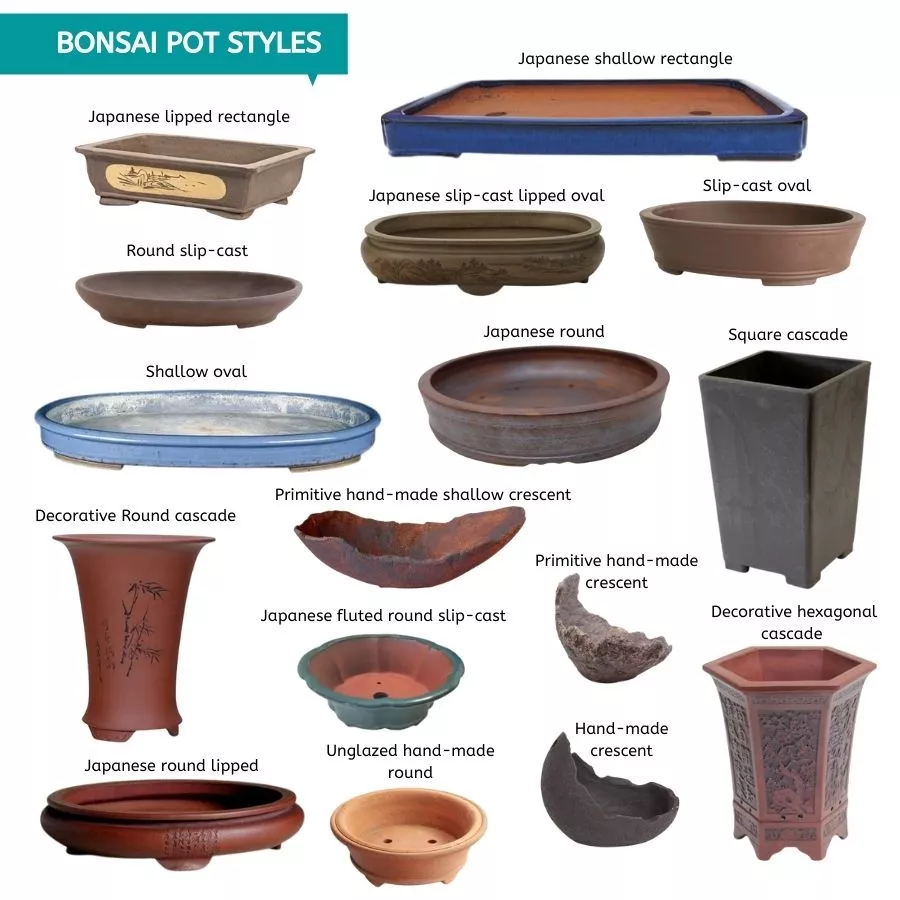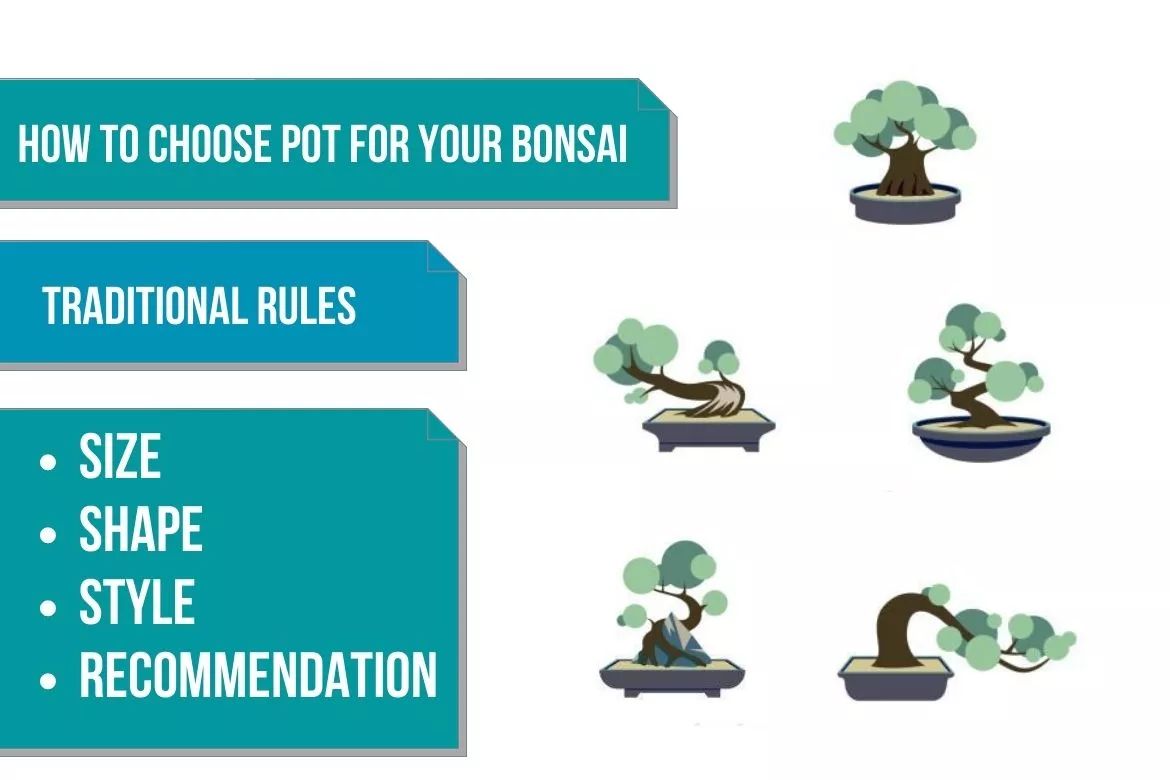A bonsai pot may seem to be nothing more than a container for cultivating a tree to the untrained eye. In reality, however, the pot is one of the most important parts of the overall effect.
It is very important for the pot to blend well with the tree, to create a harmonious and well-balanced composition of the tree and the pot, making them a “single unit“. This basic but crucial principle applies to all types of bonsai trees and all types of bonsai styles.
Imagine you made a beautiful painting. Now you are trying to select a frame for it. You will choose the frame which complements the art and design of the painting. At the same time you would want to maintain a balance so that the design of the frame doesn’t dominate the art piece it is intended to show.
Same principle applies to growing bonsai trees. Here, the bonsai tree is the painting and the bonsai pot is the frame.
Additionally, you always choose a frame for your painting after the painting is completed. Similarly, you choose a bonsai pot after the styling of the bonsai tree.
Initially, your eye should be drawn to the bonsai tree, then the bonsai pot follows as a complementary design element. On the other hand, when it is the opposite, then the bonsai pot will be considered as the dominant design feature.

When viewing the composition (the bonsai tree design plus the bonsai pot), there should be no conflict over what is seen first. A bonsai tree’s lower trunk should be the first thing that draws the attention of the eye, then the focus moves up to its apex to appreciate its design. All of this followed by observing and admiring the bonsai pot as a framing (and not as a dominant factor) for the whole presentation
General rules of choosing a bonsai tree pot
The art of bonsai hinges on the marriage of tree and pot. That means choosing the bonsai pot that best suits your tree can be a bit tricky. When choosing a pot for your bonsai, you need to follow some traditional rules.
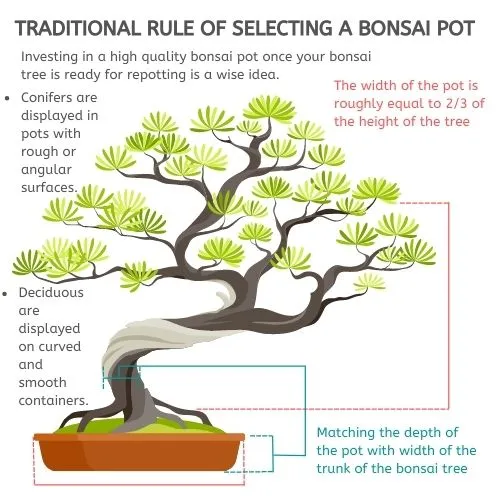
- The width of the pot should be equal to 2/3 of the height of the bonsai tree
- The height of the pot should at least match the diameter of the base of the trunk
- Its shape color and texture should match and compliment the bonsai tree
- Rugged conifers are displayed in rough or angular pots
- Deciduous trees are paired with curved and smooth bonsai pots
- For deciduous trees, glazed or semi-glazed pots are used
- For evergreens or conifers, unglazed or matte finish pots are used
- For displaying broad-leaf trees, glazed pots of various colors are better, but they should never be very bright in color. Rather, the color of the glaze should blend beautifully with the shade of the foliage or with the color of the trunk.
- The bonsai pots must be frost-proof if it is being used for outdoor bonsai tree in temperate climate, which is why they should be made of stoneware fired at a high temperature.
- Mica and plastic pots are suitable for beginners or as temporary training pots, but stoneware pots definitely give trees a more attractive appearance.
- You should also choose a container that accentuates the form and color of the bonsai specimen, without overwhelming it.
- The pot should drain well from drainage holes, but remain moist enough to maintain the tree’s health.
- Bonsai pot should have a flat bottom (should not bow upward in the center), so that there are no pools of water that can remain for a prolonged period of time.
- There should be enough space for the soil to allow the roots of the bonsai tree to grow.

Choosing the shape and color
Shape
Shallow pots are best for plants with slender trunks or group plantings, while larger pots are best for thick trunks to keep a balanced visual effect.
The graceful, lowland styles of bonsai trees look best in oval pots or soft-cornered rectangular pots with curved profiles.
Pots with rectangular shapes go well with bonsai with strong, angular or twisting trunks.
Bonsai styles with wide, spreading foliage work well with pots that flare out at the top or have a lip around the rim.
Trees with straight, slender trunks are complemented by very simplistic, round pots or square pots.
Pot should be slightly narrower than the bonsai tree spreads in order to be in visual proportion.
Color
Japanese maples or zelkovas, with their delicate foliage, look magnificent in pots with subtle pastel glazes.
Dark-leaved deciduous trees like elms, serissas, azaleas and azaleas can use a deep-colored glazed pot.
A brown or beige colored pot with a matte, unglazed finish works best with junipers and yews, which have rich, chestnut-red bark.
A pine bonsai with its rich green foliage and dark-rough bark is accentuated by deep red or rich brown colored bonsai pots. A natural surface texture of the pot is an additional bonus.
To balance the impact of a flowering bonsai in full bloom, a pot of a more highly colored hue is necessary. You can choose any color you like for the pot (try to complement the color of the flowers with the pot color), however try to avoid bright colors and high-gloss glazes.
Consider your container carefully, and if you are uncertain, consult a bonsai artist who can assist you in selecting the perfect pot for your bonsai.
Bonsai tree pot categorization based on pot treatment
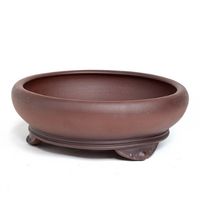

- Unglazed bonsai pots – Unglazed bonsai pots are made of just pure clay and do not contain any contaminants or any glaze treatment. These are porous in nature and which can help in aeration and excess water evaporation. However, these pots are not environment proof. Generally, unglazed or matte finish pots are used to plant conifers and evergreen bonsai.
- Glazed bonsai pots – Glazed pots are clay pots which are treated with a glaze (either painted or dipped). These pots are weather resistant. Additionally, they lack the porous nature of a clay pot. Generally, glazed or semi glazed pots are used to plant deciduous plants.
Quick tip: In case you are planning to get a glazed pot, try and get a pot which is glazed from outside till the inside edge of the pot. Opt for a pot which is not glazed from inside. This assists the tree in stability when the roots grow and start touching the inside of the pot.
Continue reading bonsai pot material for an in depth guide.
Bonsai tree pot categorization based on size
Bonsai tree pots can be categorized in different categories depending on their size and shape:
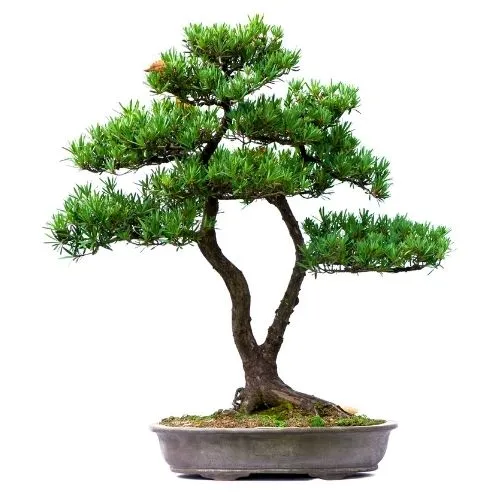
Bonsai Large Containers – Large bonsai containers are those that contain more than a 2 pounds or so of bonsai soil. The bonsai soil meant for these containers has large particle size in the range of 1/8 to 3/8 of an inch. This facilitates proper air circulation.

Bonsai Small Containers – Small bonsai containers are those that contain less than 2 pounds of bonsai soil. The bonsai soil meant for these containers has particle size of 1/8 an inch. Although competitively finer in texture than large container bonsai soil, this soil still manages to provide adequate aeration and water retention.
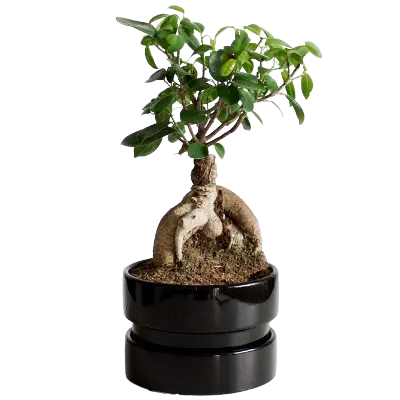
Bonsai Tiny Containers – Very small bonsai containers (also sometimes called as mame pots) which can only hold 1 or 2 cups of bonsai soil are called tiny bonsai pots. The low amount of soil results in lower moisture retention and hence the soil dries out quickly. Therefore, these types of tiny bonsai containers need more frequent monitoring.

Bonsai Shallow Containers – Shallow containers look very attractive in certain bonsai compositions, making them a popular option among bonsai enthusiasts. However, growing a bonsai tree can be a little trickier than other bonsai containers. Initially, the shallow container will hold more moisture. However, because of the large surface area, the soil in shallow bonsai pots tends to lose moisture at a faster rate.
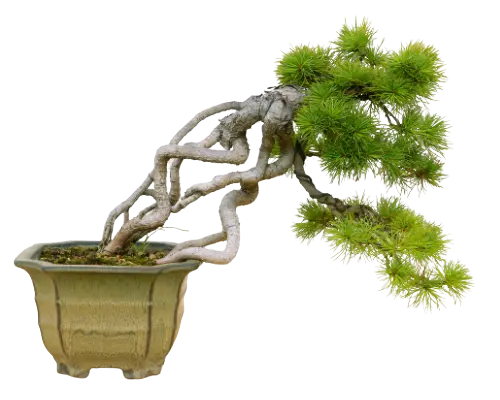
Bonsai Deeper Containers – Growing bonsai in deep containers is relatively easier than shallow containers. Because, in contrast to shallow bonsai containers, the same volume of bonsai soil will retain moisture for a longer period of time (resulting in less frequent monitoring) in deep containers. Deep container is also able to hold more air for the roots of the bonsai tree.
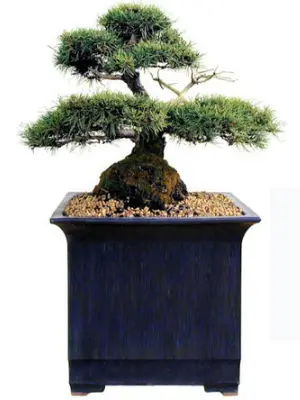
Bonsai Oversize Containers – Creating a bonsai composition isn’t just about following tradition but also about incorporating artistic sensibilities. The bonsai grower can in some cases use an oversized container (a pot which is too large for the bonsai tree) to complement his bonsai style.
However, using an oversized container is more likely to result in soggy soil as the volume of soil is large and the roots to absorb the moisture are less. The roots have more probability of rotting. Also there is less air in the soil because the bonsai soil is taking time to get rid of excess moisture.
Be careful while watering and if you think that you are not able to manage the bonsai tree in an oversized container, move it to a smaller container as soon as possible.
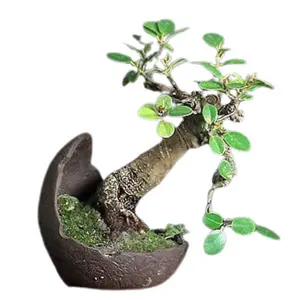
Bonsai Tricky Containers – Tricky containers are containers that do not confine their designs to a certain shape and size or need experienced bonsai growers to deal with them. These pots are generally less than 2 inches deep and not more than 6-7 inches wide. For instance, shallow crescent bonsai containers or pots that are too small for a bonsai tree. Tricky containers are not advised to beginner bonsai growers as they are hard to balance and water.
Bonsai tree pot categorization based on shape
Bonsai pot can have numerous shapes. However, most common and popular shapes are listed below:
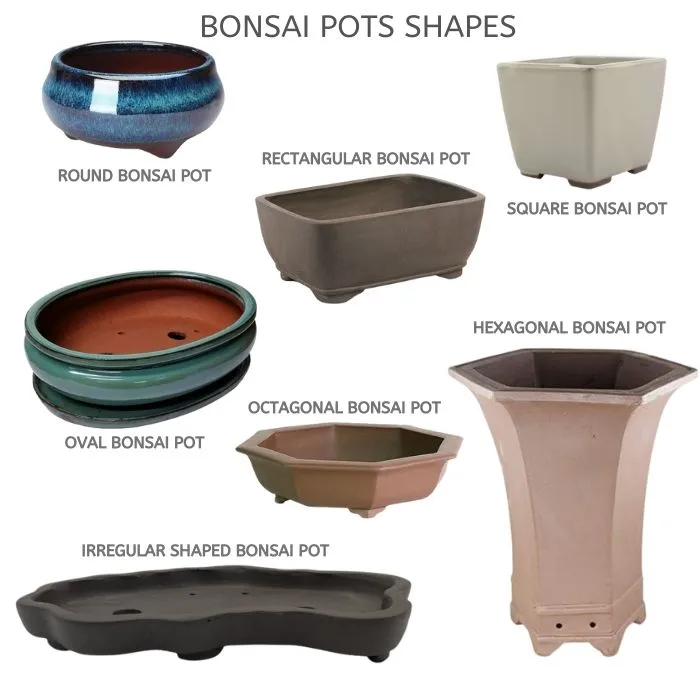
- Round pots – These pots are mostly suitable for trees with thinner and fragile looking trunks. Literati bonsai plants are a good choice for this type of pot.
- Rectangular pots – Heavy trees with thick trunks and branches are best suited to these pots.
- Square pots – Similar to round pots, these pots are also opted for planting bonsai trees with thin trunks. Literati bonsai style.
- Oval pots – Pots with oval shape are generally used for forest bonsai style.
- Hexagonal or Octagonal pots – These pots are a great choice for displaying symmetrical literati bonsai style.
- Irregular shape pots – Irregular pots such as crescent pots are mostly used for drift wood or windswept bonsai style.
Bonsai tree pot categorization based on style
A wide range of bonsai pot styles can be found in bonsai shops and nurseries. Various ceramic artists from all over the world produce hand-made pots to suit bonsai. Here is a sample of some of the bonsai pot styles available:
